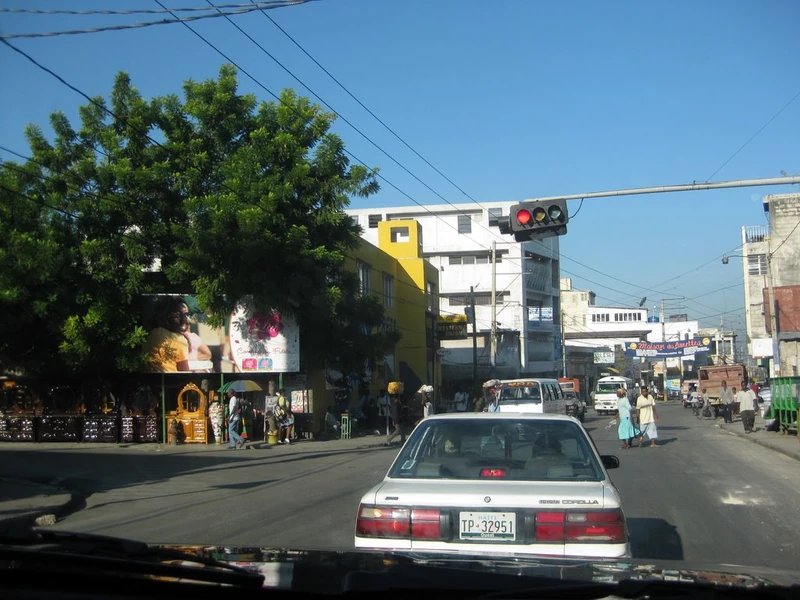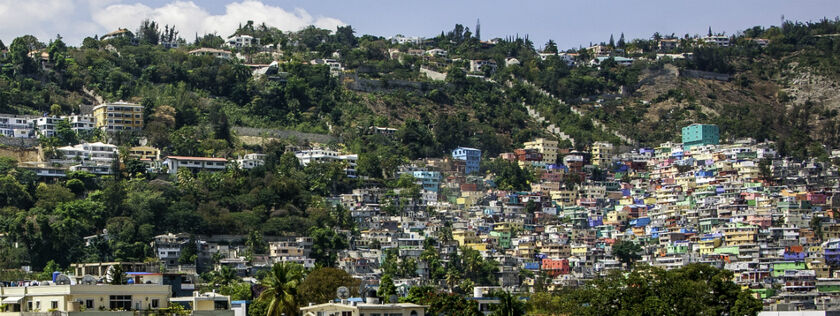"If you took all the money in the world and divided it equally among everybody, it would soon be back in the same pockets."
Si ou te pran tout lajan nan mond lan ak divize li egalman nan mitan tout moun, li ta byento ap tounen nan pòch yo menm.
-Jim Rohn
Pétion-Ville, (erroneously written Pétionville or Petionville); (Kreyol: Petyonvil) is a commune in the Port-au-Prince Arrondissement, Ouest Department of Haiti. In 2013, Pétion-Ville was ranked number ten by MondoBlog magazine on its top-ten list of the "most beautiful communes" in Haiti.
Pétion-Ville is Haiti's fourth largest city. Founded September 23rd, 1831 under the presidency of Jean-Pierre Boyer, Pétion-ville was chosen at the beginning as a defending city to keep the Haitian Army's archives from any possible attack from the French.
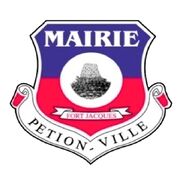
About[]
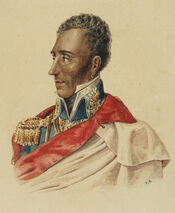
Jean-Pierre Boyer, 2nd President of Haiti
This town is located in the suburbs of Port-au-Prince, on a hill nicknamed La Charbonnière ("the coal cutter") because it provided much of the charcoal to the city. It was a famous resort.
This town was founded in 1831 by President Jean-Pierre Boyer, and was named after Alexandre Sabès Pétion (1770-1818), recognized as one of the four founding fathers of the country. From the second half of the nineteenth century, Pétion-Ville became the residence of many Port-au-Princiens who came to get a little cool.
This commune is mainly residential and tourist; the community of the city is very multi-cultural and consists of mainly immigrants of Hispanic and Chinese origin. In 2013, the population census shows 283,052 inhabitants, that of 2015 gives 376,834 inhabitants. Pétion-Ville is part of the metropolitan area of Port-au-Prince. It is one of the most affluent areas, where the majority of tourist activity takes place, and one of the richest parts of the country. Many diplomats, foreign businessmen, and a large number of wealthy citizens do business and live in Pétion-Ville. Despite the distance from the capital and the general affluence of Pétion-Ville, the lack of administrative rigor in the management of the city has led to the formation of slums on the outer edges of the region. The less well-off people migrate to the mountains and settle in search of employment opportunities.
History[]
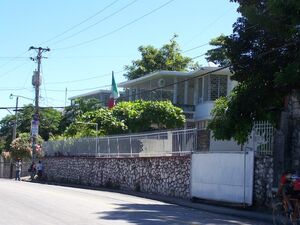
Embassy of Mexico
During the period when Alexander Pétion was in power, he did not have the vocation nor the claim to found a city called today Pétion-Ville. Twenty seven years after the proclamation of the National independence, Jean Pierre Boyer came to power and found it good to start a city in memory of this hero of the War of Independence. He founded a city at La Coupe (the centre of a canton specializing in the manufacture of charcoal) which bore the name of Alexandre Pétion. After Boyer, several presidents brought their touches to the city: Salomon had a drinking water system installed; Borno a paved road, Rue Grégoire; Vincent confided to the architect Franck Jeanton the creation of the Place D'Armes (Place Saint-Pierre Ex-place of the government) and ensured the electrification of the streets; Lescot had the halls of the public market erected; François Duvalier made built the Lycée and his son finished the Market Simone, (Nancy Roc, Audience Magazine, September 1997). [1]

Alexander Pétion, 1st President of Haiti
Pétion, who died in 1818, left a lasting imprint upon his homeland. He ruled under two constitutions, which were promulgated in 1806 and 1816. The 1806 document resembled in many ways the Constitution of the United States. The 1816 charter, however, replaced the elected presidency with the office of president for life.
Pétion’s largely laissez-faire rule did not directly discriminate against blacks, but it did promote an entrenched mulatto elite that benefited from such policies as the restoration of land confiscated by Dessalines and cash reimbursement for crops lost during the last year of the emperor’s rule. Pétion was a beneficent ruler, and he was beloved by the people, who referred to him as “Papa Bon Coeur” (Father Good Heart). But Pétion was neither a true statesman nor a visionary. Some have said that his impact on the nations of South America, through his support for rebels such as Simón Bolívar Palacios and Francisco de Miranda, was stronger and more positive than his impact on his own impoverished country.
Having become in the 1970s the place of residence of the elites of the country, the municipality faces and challenges major factors, including the population explosion. This phenomenon has had serious repercussions on the municipality. Originally built to accommodate a few hundreds of inhabitants, Pétion-ville has been experiencing accelerated urban growth for some time. The commune, whose population growth is largely due to the rural exodus, was nearly 350,000 inhabitants at the 2015 census.
At the beginning of the century, the area on which Bristout-Bobin today extends was filled with forests. As no exception to the rest of Haiti, the area was deforested little by little, and the wood was burned to make coal. The latter is used as a source of energy for cooking by nearly 88% of the population of the country.
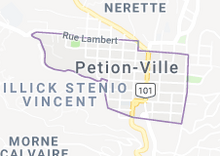
Petion-ville. Click here to view street map.
The town of Pétionville is located on a hill near the Haitian capital nicknamed "la coupe charbonnière" as it supplied much of the charcoal to the capital. The first inhabitants of the neighborhood settled in the 1940s. They were day laborers coming from the provinces to take advantage of the jobs of the capital. These populations have imported a rural way of life that has resulted in the cultivation of cassava, potatoes, peas and livestock, made possible by a low density.
Timeline
• In 1791, the freedmen of the West and the South, after having chosen their Port-Republican (Port-au-Prince) leaders went to camp at La Charbonniére, La Croix-des-Bouquets and in Mirebalais.
• On March 10, 1792, a column of troops sent from Port-au-Prince against the freedmen of Croix-des-Bouquets passed through by La Coupe (Pétion-ville).
• On July 5, 1794, the civil commissioners Sonthonax and Polverel left La Coupe, crossed Morne Malanga, one of the hills of the Selle Chain (since then, Morne des Commissaires) and arrived in Jacmel the next day. The leader of the bands, Dieudonné, occupied the mountains of Malanga and those of Grand-Fond in the name of the French Republic.
• In 1796, the English general Forbes had La Coupe fortified. none of these fortifications remain today,
• In 1797, Pétion surrounded the Fort de La Coupe commanded by an English officer named Kerenskoff. After an hour of fighting, he kidnapped him on December 5. After capturing the fort, he settled at Gros Morne, a high mountain on the border with Port-au-Prince, surrounding it from that side. On February 15, 1798, the English left the place definitively.
• In 1802, the Chemin de la Coupe in Port-au-Prince was occupied by the leader of the bands Jean Rouge against the French. Lamour Dérance, which he obeyed, had established an entrenched camp at La Coupe as well as at Freres.
On December 16, General Fressinet, at the head of 1,500 men removed the La Coupe camp. He seized another camp established higher up at Tete-de-l'eau. During the Cacos war against Salnave, Pétion-ville embraced the Cacos party. These besieged on this side disagreements that had erupted in their camp, the siege was raised on August 1, 1868, and the Cacos of Pétion-ville and of the Croix-des Bouquets won Saint Marc. Those from the South and Jacmel who held the road to Bizoton and Carrefour, won their respective legalities for defending oneself against the Piquets raised behind them in favor of Salnave.
• December 19, 1869, the day after the entry of the Port-au-Prince Cacos, President Salnave, unable to hold at the national palace, fled from the capital and passed Pétion-ville to go to the eastern part. French astronomers Abadie, Calandran and Dupuy came there to observe the passage of Venus over the sun's disk on December 6, 1882.
• On July 16, 1889, the Northerners spread across the Cul-de-Sac Plain, attacking Pétion-ville, but they were repulsed, abandoning their corpses, luggage and wounded. The Minister of the Interior Maxi Monplaisir distinguished himself in this affair; after having set fire to the most beautiful properties, he was obliged to evacuate the place on the night of August 19, enveloped on all sides by enemy forces. Faced with this event, and seeing the whole South as a common cause with the Northerners, President Legitime, reduced to defending himself in the only city of Port-au-Prince, decided to abdicate on August 22 in the afternoon.
• On March 18, 1907, construction of the Petion-ville railway was commenced in the presence of Mrs. G. Tippenhaurer, Stéphen Archer, General J. Carrié and J. Nicolas. The works have started at Carrefour Vincent, following the path of Mais-Gaté, Caradeux, Moquette, and Freres.
Geography[]
Pétion-ville is located at 18.5138° N, 72.2882° W. According to the IHSI, this commune has a total land area of 165.49 square kilometers (63.90 square miles), of which 85.10 km² (51%) is rural 43.05 km² (26%) is suburban, and 37.34 km² (23%) is urban. It is bordered on the north by the city of Delmas, on the east by Croix-des-Bouquets, on the south by the town of Kenscoff, on the west by the city of Carrefour, and on the northwest by the city of Port-au-Prince. Pétion-ville has five communal sections and one district. Its topography is inland, consisting primarily of hills, and its climate varies depending on where one is located.
To the southeast is the Kenscoff Plateau, so known for its peach trees, apple trees, and other fruits from Europe.
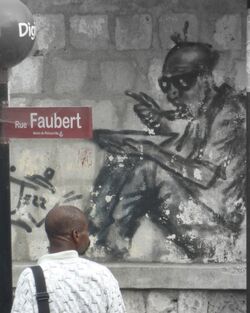
Demographics
Its inhabitants are called Pétion-Villois or Pétionpolitains.
| Year | Population | Change |
|---|---|---|
| 1890 | 12,000 | |
| 1982 | 35,333 | +194% |
| 1998 | 133,005 | +276% |
| 2003 | 283,052 | +113% |
| 2009 | 271,175 | -4% |
| 2015 | 376,834 | +39% |
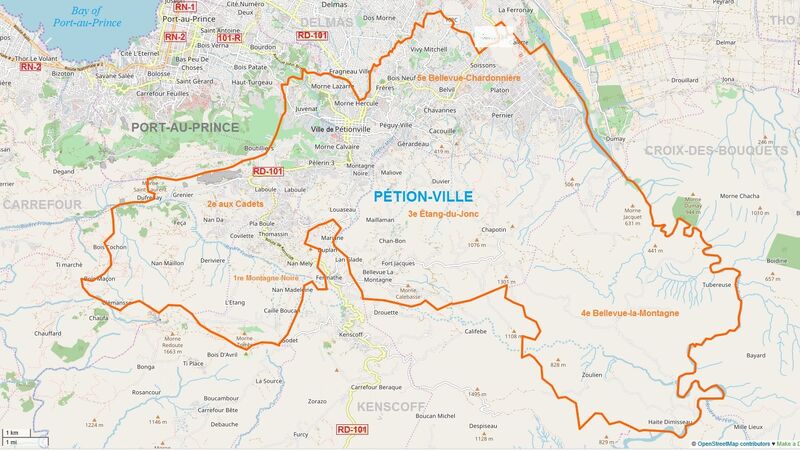
Commune Map of Pétion-Ville, Haiti
Neighborhoods
| PEV | Pétion-Ville | 376,834 | |||
|---|---|---|---|---|---|
| VPV | Ville de Pétion-Ville | Urban | 327,923 | ||
| QTM | Quartier de Thomassin | Urban | 20,798 | ||
| MON | 1ère Section Montagne Noire | Rural section* | 2,578 | Caille Boucan, Cavilette, L'Etang, Nan Mely, and Thomassin. | |
| AUC | Rural | 1,605 | Bauvais, Bois Boulalile, Cadet, Cantave , Corail, Ferrière, Hatte Dimisseau, Pérard, Savane Pite, Trou-Jacques, Tubereuse, and Zoulien | ||
| ETJ | 3ème Section Etang Du Jonc | Rural section | 5,239 | Bois Cochon, Bois Maçon, Carrefour la Boule, Clémansso, Derivière, Féca, Grenier, Habitation Corbier, La Boule, Nan Da, and Nan Maillon. | |
| BVM | 4ème Section Bellevue La Montagne | Rural | 9,551 | Au Cadet, Bellevue la Montagne, Chan Bon, Chapotin, Despinasse, Diegue, Dumiso, Dupont, Dupont-Diegue, Duval Blanc, Duvier, Fond Soie, Fort Jacques, Gréfin, Louaseau, Mailaman, Maligue, and Movette | |
| BVC | Rural section | 9,140 | Berthe, Bois-Neuf, Cacouille, Chavannes, Frères, Gerardeau, Mayotte, Métivier, Musseau, Peguy-Ville, Pernier, Platon, Soissons, and Tête de l'Eau |
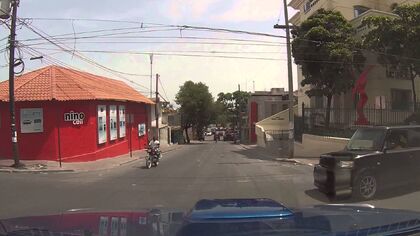
Corner in Downtown Pétion-Ville, Haiti
Economy[]
For economic and financial infrastructure, Pétion-Ville has fifteen hotels, 25 restaurants, eight banks, one Caisse populaire, and three marketing co-operative centres.
Twenty-three Markets (Big and small), 23 major stores, 15 food supply centres, 10 building materials shops, ten deposits (soft drinks and other miscellaneous items), eight gas stations, four Private morgues, 15 pharmacies, 5 photocopiers, 4 hairdressing salons, 5 beauty Studios, 4 Photo studios, two dry cleaners, several bookstores, shops and others form the commercial establishments and Economic benefits of the municipality.
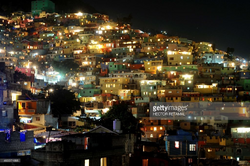
Pétion-ville Foothills at night
Infrastructure[]
Education
The Ministry of the National Education for Youth and Sports is represented by a school inspection office. 41 private kindergarten, 250 schools of which (14 public, 232 private and four of the congregationalist type) were inventoried at the primary level in the municipality. 15 secondary schools, including two public and thirteen private, 7 vocational schools, six Literacy centres and one Higher school have been listed in the commune as well.
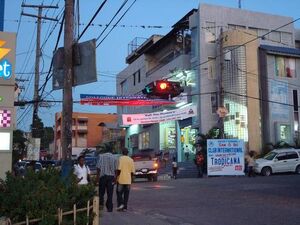
Morne Hercule neighborhood
Health
Pétion-Ville is home to more than two dozen health care establishments. The Ministry of Public Health and Population is represented by a communal health office. Healthcare is provided by six hospitals, 19 clinics, and three dispensaries. Forty-nine doctors, six Dentists, twenty nine nurses, 81 auxiliaries, 78 certified Matrons, seven laboratory technicians and 8 Radiologists were counted within the Health institutions of the commune.
Utilities
With respect to water availability, the municipality has a River, seven Springs, five lagoons and public fountains with more than fifteen taps. Virtually the entire city of Pétion-Ville is electrified.
Security
In terms of Administrative and judicial infrastructure, the commune of Pétion-Ville has a police station and a substation. There is also a Peace court and a civil status office.
Culture[]
Religion
Nearly 419 temples (chapels included) were counted in the commune. The Pentecostal temples reveal to be the most numerous, 102 in total.
Communication
Pétion-Ville has a telephone office, a post office, and three radio stations.
Leisure

Two local eatery employees smile for the camera
As for leisure, the commune has two libraries and a cinema room. There is not a museum or a theatre.
The sports are football (soccer), basketball, volleyball, tennis, and athletics.
For monuments and sites, it has three which are of natural, historical and colonial type. There is a need to underline the existence of a good number of art galleries in the municipality of Pétion-Ville. From the town of Port-au-Prince to Pétion-Ville via Bourdon, Rue Pan-Américaine, the multiplicity of artisanal creation (carved objects made of iron, wood, straw or other) is quite important.
Fort Jacques and Fort Alexandre, built in the aftermath of independence under the leadership of Alexandre Pétion , are part of a set of about twenty military works arranged in anticipation of a possible return of the French, former masters of the colony of Santo Domingo.
Nightlife
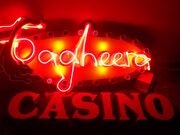
Bagheera Casino Pétion-Ville
Pétion-Ville is an affluent part of Haiti, where many multiracial Haitians live. Avenues like Laboule and Morne Calvaire are known for their mansions. There is an extreme, almost feudal gap between the rich and the poor in Haiti. The closed and guarded private neighborhoods resemble a Haitian version of Beverly Hills. Most residents of Pétion-Ville are affluent compared to residents of most other areas of the country. Pétion-Ville has more security than the center of Port-au-Prince, and, in general, than the other big cities of Haiti. The community is very stable, with a vibrant nightlife and a business center with the appearance of Western normality.
The suburb is filled with nightclubs, beauty salons, gyms and French restaurants. Hotels and other businesses that welcome tourists are often frequented, and most of these meetings take place at night. Institutions often host large expatriates and foreigners of a similar caliber.
The famous hotel "El Rancho" is in Pétion-Ville. It was built from the private property of Albert Silvera , a collector of sports and luxury cars that was one of the pioneers of Haiti's hotel industry.
Organizations
Six Political parties have representation in the commune. Five Popular organizations, two non-commercial co-operative centres, four NGOs and one International organization were also inventoried in the municipality.
References[]
"Christophe's Kingdom and Pétion's Republic" - [2]
Michael Vedrine
